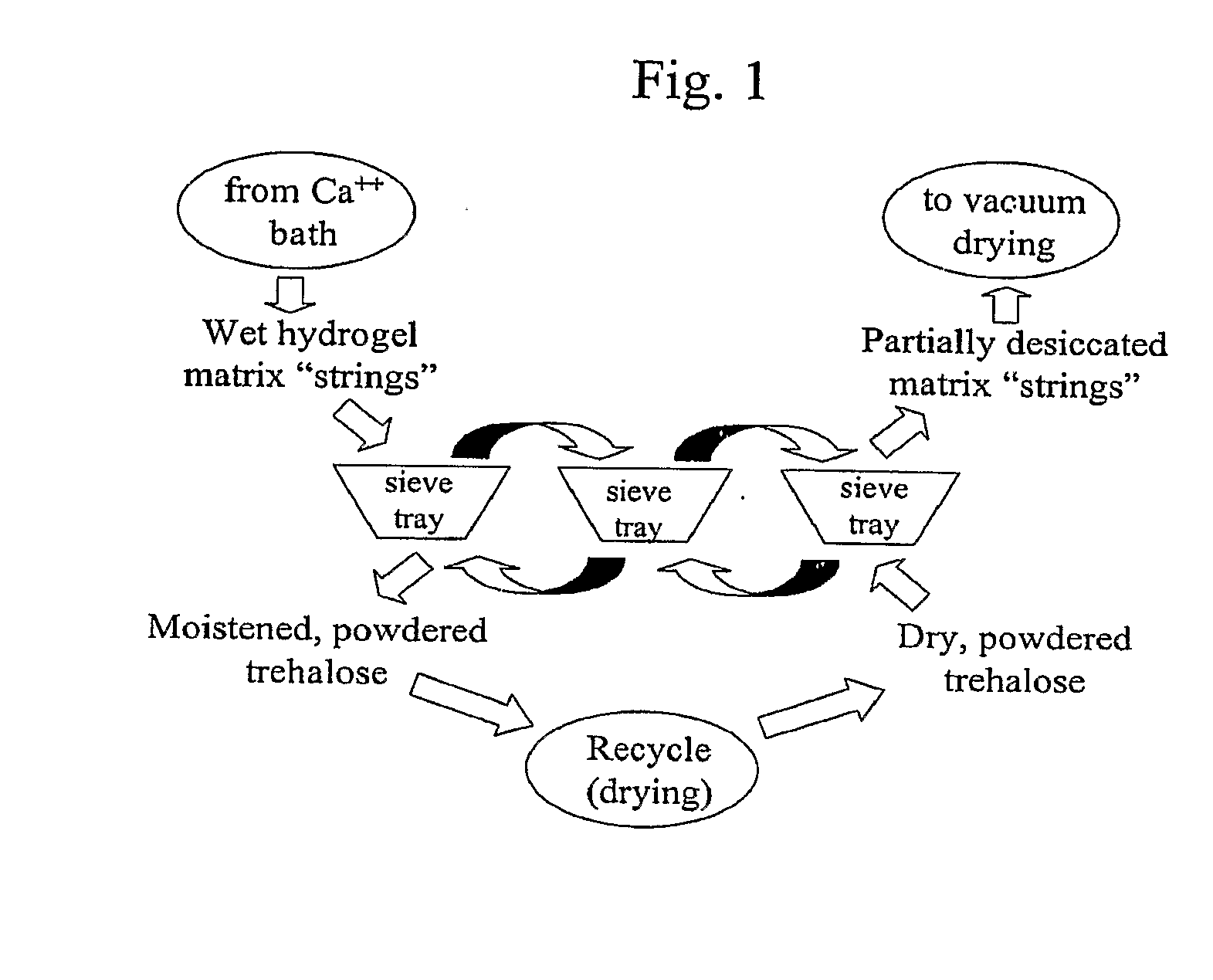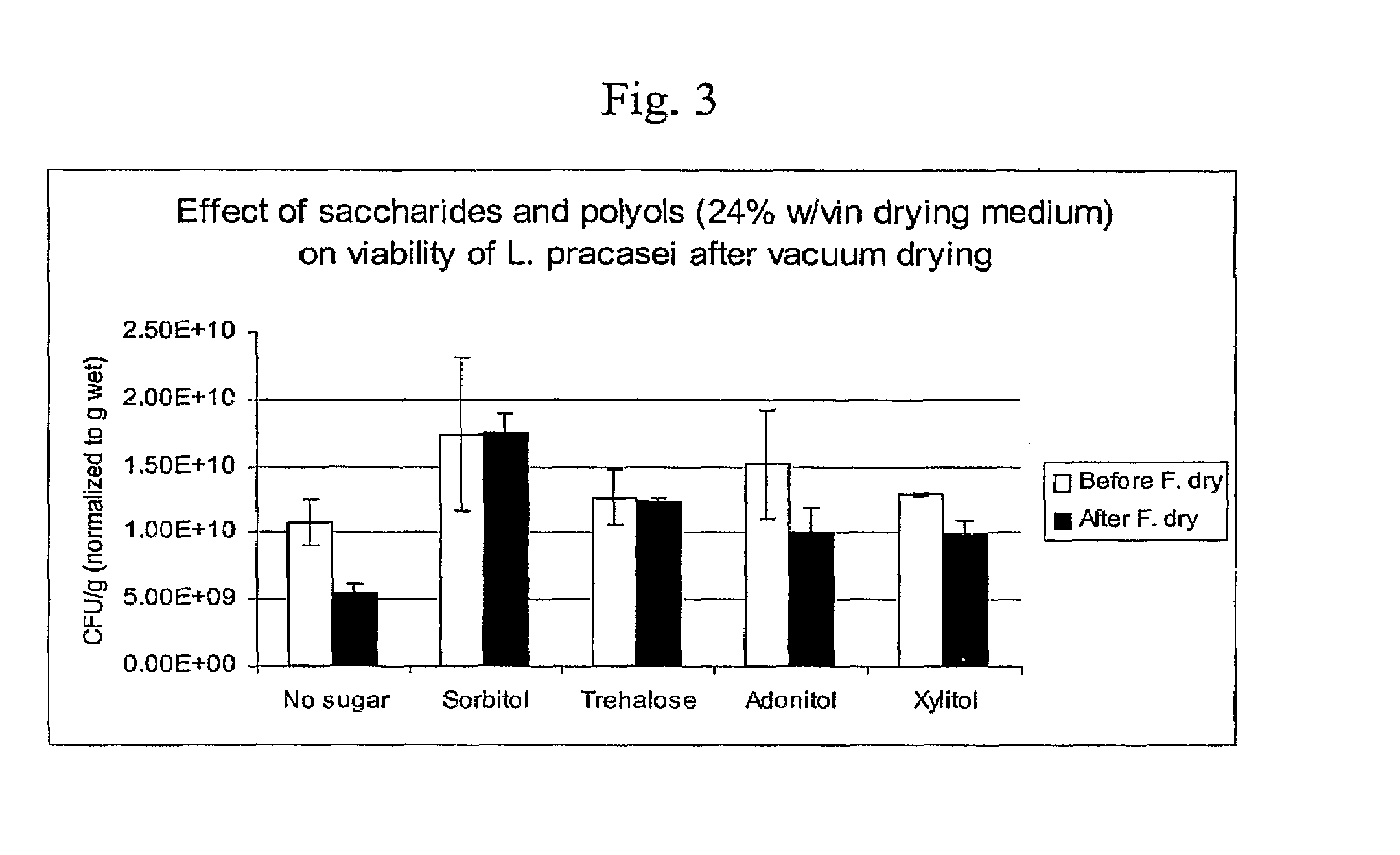Delivery vehicle for probiotic bacteria comprising a dry matrix of polysaccharides, saccharides and polyols in a glass form and methods of making same
- Summary
- Abstract
- Description
- Claims
- Application Information
AI Technical Summary
Benefits of technology
Problems solved by technology
Method used
Image
Examples
example 1
[0051]High amylose starch (100 g Novation, National Starch and Chemical, Bridgewater, N.J.) was mixed with 150 ml of water at ambient temperature. The starch mixture was then slowly added to 850 ml of boiling water under vigorous mixing using a standard household blender. Once complete dispersion of the starch granules was observed (using a binocular microscope), the starch solution was allowed to cool and 300 g of trehalose and 100 g isomalt (both from Cargill Minneapolis, Minn.) were then dissolved in the mixture. Sodium alginate (15 g) was added to the slurry and the entire mixture was allowed to cool to room temperature. Lactobacillus paracasei (200 g frozen paste direct from fermentation harvest) was then mixed well into the slurry and the slurry was extruded into a 1000 ml bath (held at 0-5° C.) containing 5 g CaCl2, 300 g trehalose and 100 g isomalt using a syringe equipped with 18 G needle. The CaCl2 bath was gently stirred while injecting the slurry. The matrix strings were...
example 2
[0053]100 g of trehalose and 300 g isomalt (both from Cargill Minneapolis, Minn.) were added to 1000 ml water and allowed to dissolve. Sodium alginate (15 g) was mixed into the slurry and allowed to cool down to room temperature. Lactobacillus paracasei (200 g frozen paste as in Example 1) was then added to the slurry, followed by 5 g of calcium phosphate dibasic and 5 g of gluconolactone. The slurry was allowed to cross-link at room temperature over the next 4 hours. The firm gel was sliced to thin and long threads through cheese grinder and blotted on paper towel. The composition of the gel matrix is provided in Table 2.
TABLE 2Gel matrix composition (g dry weieht / 100 g)trehalose10 gIsomalt30 gSodium Alginate1.5 g L. paracasei20 gWater100 g
[0054]The thin threads were loaded on a tray (13×10 inch) and placed in a freeze drier for drying as outlined in example 1.
example 3
[0055]300 g of trehalose (Cargill Minneapolis, Minn.) and 100 g mannitol (Sigma) were added to 1000 ml water and allowed to dissolve. Sodium alginate (15 g) and pectin (5 g) were mixed into the slurry and the slurry was allowed to cool down to room temperature. Lactobacillus acidophilus (200 g frozen paste, directly from a fermentation harvest) was mixed well into the slurry. The slurry was then extruded through a syringe equipped with 18 G needle into 1000 ml bath (0-5° C.) containing 5 g CaCl2, 300 g trehalose and 100 g mannitol. The CaCl2 bath was gently stirred while extruding the slurry. The formed strings were allowed to cross-link for 30 minutes, harvested, and blotted on paper towel. The composition of the gel matrix is provided in Table 3.
TABLE 3Gel matrix composition (g dry weight / 100 g)trehalose30 gMannitol10 gSodium Alginate1.5 g Pectin0.5 g L. acidophilus20 gWater100 g
[0056]The thin threads were loaded on a tray (13×10 inch) and placed in a freeze drier for drying as o...
PUM
| Property | Measurement | Unit |
|---|---|---|
| Temperature | aaaaa | aaaaa |
| Temperature | aaaaa | aaaaa |
| Time | aaaaa | aaaaa |
Abstract
Description
Claims
Application Information
 Login to View More
Login to View More - R&D
- Intellectual Property
- Life Sciences
- Materials
- Tech Scout
- Unparalleled Data Quality
- Higher Quality Content
- 60% Fewer Hallucinations
Browse by: Latest US Patents, China's latest patents, Technical Efficacy Thesaurus, Application Domain, Technology Topic, Popular Technical Reports.
© 2025 PatSnap. All rights reserved.Legal|Privacy policy|Modern Slavery Act Transparency Statement|Sitemap|About US| Contact US: help@patsnap.com



